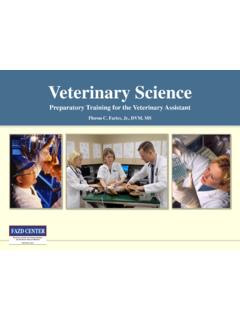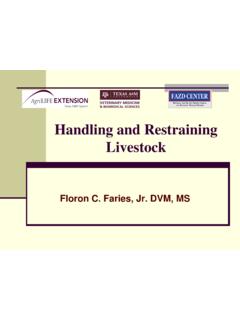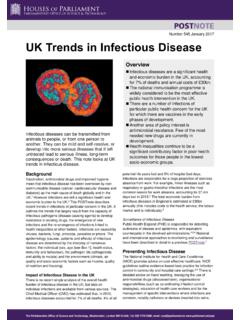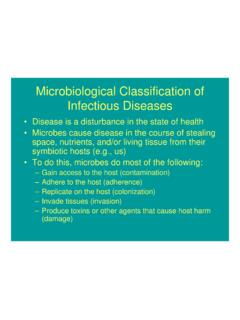Transcription of Causes of Infectious Diseases - Texas A&M University
1 Chapter 10 - Infectious Diseases217 Chapter 10 - Lesson 1 Causes of Infectious DiseasesIntroductionInfectious Diseases are caused by exposure to living organisms not normally present in the animal. Ani-mals are exposed directly or indirectly to Infectious organisms in many ways, including breath, urine, or manure of other animals, and from arthropods. Infec-tious agents enter the individual through the skin, mu-cous membranes, lungs, mouth, or reproductive tract. Agents, such as germs (bacteria, viruses, fungi, rick-ettsiae) and parasites (worms, protozoa, arthropods), infect or infest various tissues and organs of animals and humans.
2 The germs and protozoa invade and mul-tiply inside or outside of tissue cells, while worms (helminths) and arthropods invade and develop in the lumen of hollow organs and between cells of tis-sues. Tissue damage results from increased pressure, adverse reactions, toxins, or feeding by the disease agents. Infectious disease AgentsBacteriaVirusesFungiRickettsiaeHel minthsProtozoaArthropodsCausative AgentsVirusesViruses are very small non-cellular organisms that consist mainly of genetic material with no cellular structure. They are too small to be viewed directly un-der a light microscope.
3 Viruses infect animal cells by highjacking the cellu-lar material to replicate. Once viruses infect cells, it is the damage to the cells that Causes the outward clini-cal symptoms of viral disease . Viruses often infect specific types of cells causing damage to the tissues or organs that those cells make up. Similar to bacte-rial disease , viruses can be found in the bloodstream, which is called viremia. Viruses are causative agents of many types of animal Diseases . Encephalitis (viral).Chapter 10 - Infectious Diseases218 Anthrax (bacterial).After replication, viruses may remain inactive (dor-mant or latent) displaying no clinical signs of disease .
4 They may then reactivate (recrudesce) and begin to multiply again. This can happen in animals that are stressed and may cause tissue damage after an ex-tended latency period of weeks to months. At the end of either a normal or an extended latency period the infected animals may show clinical symptoms of dis-ease, results of laboratory tests may be positive, and the animal may be contagious and shed the virus. A sick animal may develop a viral disease from a recent exposure (normal incubation period) to a viral infec-tion or from a previous exposure (extended incubation period).
5 BacteriaBacteria are tiny single-celled organisms that usually require a high-powered microscope to be seen. Some bacteria cause tissue reactions that may or may not produce pus, and some produce harmful or poison-ous waste products. Bacteria in the blood is referred to as bacteremia; harmful bacterial waste products in the blood septicemia; and toxins in the blood toxemia. Bacterial Diseases , which may be either primary or secondary, occur after a normal incubation period or reactivation of a dormant infection. Primary bacterial Diseases are caused by invasion of bacteria that cause disease with no other predisposing factors.
6 Secondary bacterial Diseases are caused by invasion of bacteria after a predisposing condition, such as viral infections , stresses, tissue injuries, and dietary upsets. A bacterial disease may affect a single tissue or organ, or it may affect multiple tissues and organs of the animal. Gen-eralized conditions are infections of multiple organs. RickettsiaeRickettsiae are bacteria-like organisms that can cause Diseases producing symptoms such as fever, anemia, edema, icterus, hemorrhages of mucous membranes, and enlarged spleen and lymph nodes. Depending on exposure levels and degree of immu-nity, the disease may be mild or severe.
7 Death may be caused by acute disease in young animals and chronic disease in older animals. Acute Diseases occur in the summer during vector season, and chronic Diseases during times of stress, such as inclement weather and poor are transmitted when ticks and sucking lice feed on the animal. The organisms are regurgi-tated from the stomach of the arthropod into the bite wound or passed in the feces of the arthropod and introduced into the bite wound. The transmission is biological since the rickettsiae develop and live for months in the arthropod.
8 Rickettsiae are also trans-mitted mechanically by biting flies, instruments, and blood transfusions. Rickettsiae can only survive for a short time outside a host, so mechanical transmission must occur within a few minutes. Instruments capable of transmitting rickettsial infection include needles, syringes, tattoo keys, nose tongs, and ear tag are single-celled organisms that are larger than bacteria and can often be viewed at low power under a microscope. A single organism is called a fungus and multiple organisms are called fungi. Fungi cause disease in a similar manner to bacteria, although primary fungal 10 - Infectious Diseases219diseases are uncommon.
9 Fungal Diseases may also be called mycosis or mycotic Diseases . Some fungi infect the superficial layer of skin (such as the ringworm fun-gus), and others invade various body systems (such as the aspergillus fungus). ParasitesCommon parasitic Diseases of animals are caused by arthropods, worms, and protozoa. Arthropods (flies, ticks, fleas, lice, mites) generally in-fect the skin and digestive system; worms (nematodes, tapeworms, flukes) infect the skin, digestive system, and circulatory system; and protozoa infect the diges-tive and reproductive systems. Parasitic infections de-velop into Diseases with clinical signs when parasites occur in large numbers.
10 Some parasites serve as me-chanical or biological vectors of Diseases caused by bacteria, viruses, rickettsiae, and worms. Risk FactorsRisk factors may predispose an animal to disease . Multiple causative factors increase the probability of disease in the individual. Protective measures such as immunizations, husbandry, management practices, and crossbreeding decrease the risk that disease will occur. Primary Causative FactorsThe infection of a causative agent is the primary cause of an Infectious organisms, which rely on tissue damage from a primary cause to invade and multiply, are sec-ondary invaders.












